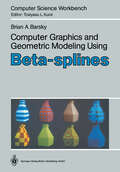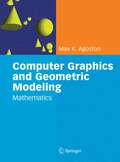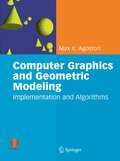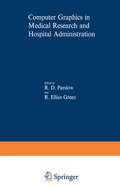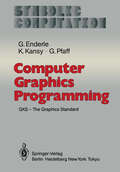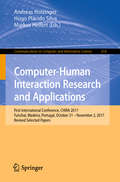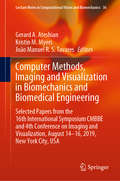- Table View
- List View
Computer Graphics and Geometric Modeling Using Beta-splines (Computer Science Workbench)
by Brian A. BarskyComputer Graphics and Geometric Modelling: Mathematics
by Max K. AgostonPossibly the most comprehensive overview of computer graphics as seen in the context of geometric modelling, this two volume work covers implementation and theory in a thorough and systematic fashion. Computer Graphics and Geometric Modelling: Mathematics, contains the mathematical background needed for the geometric modeling topics in computer graphics covered in the first volume. This volume begins with material from linear algebra and a discussion of the transformations in affine & projective geometry, followed by topics from advanced calculus & chapters on general topology, combinatorial topology, algebraic topology, differential topology, differential geometry, and finally algebraic geometry. Two important goals throughout were to explain the material thoroughly, and to make it self-contained. This volume by itself would make a good mathematics reference book, in particular for practitioners in the field of geometric modelling. Due to its broad coverage and emphasis on explanation it could be used as a text for introductory mathematics courses on some of the covered topics, such as topology (general, combinatorial, algebraic, and differential) and geometry (differential & algebraic).
Computer Graphics and Geometric Modelling: Implementation & Algorithms
by Max K. AgostonPossibly the most comprehensive overview of computer graphics as seen in the context of geometric modelling, this two volume work covers implementation and theory in a thorough and systematic fashion. Computer Graphics and Geometric Modelling: Implementation and Algorithms, covers the computer graphics part of the field of geometric modelling and includes all the standard computer graphics topics. The first part deals with basic concepts and algorithms and the main steps involved in displaying photorealistic images on a computer. The second part covers curves and surfaces and a number of more advanced geometric modelling topics including intersection algorithms, distance algorithms, polygonizing curves and surfaces, trimmed surfaces, implicit curves and surfaces, offset curves and surfaces, curvature, geodesics, blending etc. The third part touches on some aspects of computational geometry and a few special topics such as interval analysis and finite element methods. The volume includes two companion programs.
Computer Graphics and Mathematics (Focus on Computer Graphics)
by Bianca Falcidieno Ivan Herman Caterina PienoviSince its very existence as a separate field within computer science, computer graphics had to make extensive use of non-trivial mathematics, for example, projective geometry, solid modelling, and approximation theory. This interplay of mathematics and computer science is exciting, but also makes it difficult for students and researchers to assimilate or maintain a view of the necessary mathematics. The possibilities offered by an interdisciplinary approach are still not fully utilized. This book gives a selection of contributions to a workshop held near Genoa, Italy, in October 1991, where a group of mathematicians and computer scientists gathered to explore ways of extending the cooperation between mathematics and computer graphics.
Computer Graphics for Artists II: Environments and Characters
by Andrew PaquetteIn this second volume of Computer Graphics for Artists the author, Andrew Paquette, guides the reader through the creation of realistic computer-generated backgrounds and characters. Rather than teach using a specific program, the author focuses on the theory required to ensure that the artist can create a convincing landscape, building, person or whatever they turn their attention to. Part One covers the core areas of background generation, such as CG terrain, plant life and architecture, but also deals with specific concepts such as photo-texturing and lighting, explaining all the advantages and pitfalls involved. Part Two introduces the reader to the study of the body-shape and movement and their consequent effects upon successful digital-recreation, as well as addressing some of the fundamental elements of appearance; hair, skin and fat. It is assumed that readers will be familiar with the terms and concepts described in the first volume of this work.
Computer Graphics for Artists: An Introduction
by Andrew PaquettePacked with exercises, this book is an application-independent and reader-friendly primer for anyone with a serious desire to understand 3D Computer Graphics. Opening with the first and most basic elements of computer graphics, the book rapidly advances into progressively more complex concepts. Each of the elements, however simple, are important to understand because each is an essential link in a chain that allows an artist to master any computer graphics application. With this accomplished, the artist can use technology to satisfy his/her goals, instead of the technology being master of the artist.
Computer Graphics for Java Programmers
by Leen Ammeraal Kang ZhangThis third edition covers fundamental concepts in creating and manipulating 2D and 3D graphical objects, including topics from classic graphics algorithms to color and shading models. It maintains the style of the two previous editions, teaching each graphics topic in a sequence of concepts, mathematics, algorithms, optimization techniques, and Java coding. Completely revised and updated according to years of classroom teaching, the third edition of this highly popular textbook contains a large number of ready-to-run Java programs and an algorithm animation and demonstration open-source software also in Java. It includes exercises and examples making it ideal for classroom use or self-study, and provides a perfect foundation for programming computer graphics using Java. Undergraduate and graduate students majoring specifically in computer science, computer engineering, electronic engineering, information systems, and related disciplines will use this textbook for their courses. Professionals and industrial practitioners who wish to learn and explore basic computer graphics techniques will also find this book a valuable resource.
Computer Graphics in Medical Research and Hospital Administration
by R. ElliotGreen R. D. ParslowThe graphics terminal makes it possible for people who are not computer specialists to communicate with computers on an inter active basis, without the delay or inconvenience of working constantly through an intermediary. It provides a language of shapes or symbols (full graphics) or words and numbers (alphanumerics) which is understood by both man and machine. The visual output and input facility has considerably widened the applications of computers within the medical world, bringing their enormous powers of data handling and simulation to bear on solving problems in adminis tration, patient monitoring and clinical analysis and research. The purpose of this book is to provide examples of the work being carried out now in the U.K. and U.S.A., showing the applications of all types of installations-from small to very complex-for both administrative and research uses. It gives a brief overview of benefits already derived and of future plans; of hardware utilisation and of software approach; of problems met and of problems solved. The intention is to acquaint executives and researchers in all branches of the medical world with the rapid progress being made in computer graphics and to stimulate thought on which way the technique can be developed to the advantage of all.
The Computer Graphics Manual (Texts in Computer Science)
by David SalomonThis book presents a broad overview of computer graphics (CG), its history, and the hardware tools it employs. Covering a substantial number of concepts and algorithms, the text describes the techniques, approaches, and algorithms at the core of this field. Emphasis is placed on practical design and implementation, highlighting how graphics software works, and explaining how current CG can generate and display realistic-looking objects. The mathematics is non-rigorous, with the necessary mathematical background introduced in the Appendixes. Features: includes numerous figures, examples and solved exercises; discusses the key 2D and 3D transformations, and the main types of projections; presents an extensive selection of methods, algorithms, and techniques; examines advanced techniques in CG, including the nature and properties of light and color, graphics standards and file formats, and fractals; explores the principles of image compression; describes the important input/output graphics devices.
Computer Graphics Programming: GKS — The Graphics Standard (Symbolic Computation)
by G. Enderle K. Kansy G. PfaffFor several years the authors of this book have been involved in the design and the national and international review of the forthcoming graphical standard. When the end of this process could be foreseen and the International Standard "Graphical Kernel System" (GKS) was cast into its. final form, the urgent need arose for detailed information to the graphics community about this stan dard and for the education of graphics programmers. One major goal of GKS, besides the portability of graphical application programs and the device inde pendence, is "programmer portability" by establishing a common base for train ing of graphics programmers. Having accompanied the path of GKS from the very early stages of defining the basic concepts and designing its first versions up to the final draft of the International Standard, we feIt it worthwhile to start the venture of a text book on computer graphics programming based on GKS. This book is aimed, at one hand, at graphics users, experts and managers who want to get an overview of the new standard and a better understanding of its concepts. On the other hand, it addresses the graphics programmers who want to use GKS for realizing their graphical applications. It can serve as the base for teaching and studying functions, concepts and methods of GKS. Addi tionally, it will be a valuable source of information for implementors of GKS.
Computer Graphics Programming: GKS — The Graphics Standard (Symbolic Computation)
by Günter Enderle Klaus Kansy Günther PfaffTO COMPUTER GRAPHICS BASED ONGKS Part I gives an introduction to basic concepts of computer graph ics and to the principles and concepts of GKS. The aims of this part are twofold: to provide the beginner with an overview of the terminology and concepts of computer graphics, based on GKS, and to give the computer graphics expert an introduc tion to the GKS standard. In the early chapters of this part, the main areas of computer graphics, the various classes of com puter graphics users, the interfaces of GKS and its underlying design concepts are discussed and important terms are defined. The later chapters give an informal introduction to the main concepts of GKS and their interrelationships: output, attributes, coordinate systems, transformations, input, segments, metafile, state lists, and error handling. This introduction to the GKS framework will prepare the ground for the detailed description of 2D GKS functions in Part III and the 3D extensions to GKS in Part IV. 1 WHAT IS COMPUTER GRAPHICS? 1. 1 Defmition of Computer Graphics The Data Processing Vocabulary of the International Organization for Stan dardization (ISO) [ISO 84] defines Computer Graphics as follows: "Methods and techniques for converting data to and from a graphic display via computer. " This definition refers to three basic components of any computer graphics system - namely "data", "computer", and "display".
Computer Graphics through Key Mathematics
by Huw JonesThis book introduces the mathematical concepts that underpin computer graphics. It is written in an approachable way, without burdening readers with the skills of ow to do'things. The author discusses those aspects of mathematics that relate to the computer synthesis of images, and so gives users a better understanding of the limitations of computer graphics systems. Users of computer graphics who have no formal training and wish to understand the essential foundations of computer graphics systems will find this book very useful, as will mathematicians who want to understand how their subject is used in computer image synthesis. '
Computer Graphics Through OpenGL: From Theory to Experiments
by Sumanta GuhaFrom geometric primitives to animation to 3D modeling to lighting, shading, and texturing, Computer Graphics Through OpenGL: From Theory to Experiments, Second Edition presents a comprehensive introduction to computer graphics that uses an active learning style to teach key concepts. Equally emphasizing theory and practice, the book provides an und
Computer Graphics Through OpenGL®: From Theory to Experiments
by Sumanta GuhaCOMPREHENSIVE COVERAGE OF SHADERS AND THE PROGRAMMABLE PIPELINE From geometric primitives to animation to 3D modeling to lighting, shading and texturing, Computer Graphics Through OpenGL®: From Theory to Experiments is a comprehensive introduction to computer graphics which uses an active learning style to teach key concepts. Equally emphasizing theory and practice, the book provides an understanding not only of the principles of 3D computer graphics, but also the use of the OpenGL® Application Programming Interface (API) to code 3D scenes and animation, including games and movies. The undergraduate core of the book takes the student from zero knowledge of computer graphics to a mastery of the fundamental concepts with the ability to code applications using fourth-generation OpenGL®. The remaining chapters explore more advanced topics, including the structure of curves and surfaces, applications of projective spaces and transformations and the implementation of graphics pipelines. This book can be used for introductory undergraduate computer graphics courses over one to two semesters. The careful exposition style attempting to explain each concept in the simplest terms possible should appeal to the self-study student as well. Features • Covers the foundations of 3D computer graphics, including animation, visual techniques and 3D modeling• Comprehensive coverage of OpenGL® 4.x, including the GLSL and vertex, fragment, tessellation and geometry shaders• Includes 180 programs with 270 experiments based on them• Contains 750 exercises, 110 worked examples, and 700 four-color illustrations• Requires no previous knowledge of computer graphics• Balances theory with programming practice using a hands-on interactive approach to explain the underlying concepts
Computer Graphics Through OpenGL®: From Theory to Experiments
by Sumanta GuhaCOMPREHENSIVE COVERAGE OF SHADERS AND THE PROGRAMMABLE PIPELINE From geometric primitives to animation to 3D modeling to lighting, shading and texturing, Computer Graphics Through OpenGL®: From Theory to Experiments is a comprehensive introduction to computer graphics which uses an active learning style to teach key concepts. Equally emphasizing theory and practice, the book provides an understanding not only of the principles of 3D computer graphics, but also the use of the OpenGL® Application Programming Interface (API) to code 3D scenes and animation, including games and movies. The undergraduate core of the book takes the student from zero knowledge of computer graphics to a mastery of the fundamental concepts with the ability to code applications using fourth-generation OpenGL®. The remaining chapters explore more advanced topics, including the structure of curves and surfaces, applications of projective spaces and transformations and the implementation of graphics pipelines. This book can be used for introductory undergraduate computer graphics courses over one to two semesters. The careful exposition style attempting to explain each concept in the simplest terms possible should appeal to the self-study student as well. Features • Covers the foundations of 3D computer graphics, including animation, visual techniques and 3D modeling• Comprehensive coverage of OpenGL® 4.x, including the GLSL and vertex, fragment, tessellation and geometry shaders• Includes 180 programs with 270 experiments based on them• Contains 750 exercises, 110 worked examples, and 700 four-color illustrations• Requires no previous knowledge of computer graphics• Balances theory with programming practice using a hands-on interactive approach to explain the underlying concepts
Computer Graphics Through OpenGL®: From Theory to Experiments
by Sumanta GuhaCOMPREHENSIVE COVERAGE OF SHADERS, THE PROGRAMMABLE PIPELINE AND WEBGL From geometric primitives to animation to 3D modeling to lighting, shading and texturing, Computer Graphics Through OpenGL®: From Theory to Experiments is a comprehensive introduction to computer graphics which uses an active learning style to teach key concepts. Equally emphasizing theory and practice, the book provides an understanding not only of the principles of 3D computer graphics, but also the use of the OpenGL® Application Programming Interface (API) to code 3D scenes and animation, including games and movies. The undergraduate core of the book takes the student from zero knowledge of computer graphics to a mastery of the fundamental concepts with the ability to code applications using fourth-generation OpenGL®, as well as using WebGL® in order to publish to the web. The remaining chapters explore more advanced topics, including the structure of curves and surfaces, applications of projective spaces and transformations and the implementation of graphics pipelines. This book can be used for introductory undergraduate computer graphics courses over one to two semesters. The careful exposition style attempting to explain each concept in the simplest terms possible should appeal to the self-study student as well. Features Covers the foundations of 3D computer graphics, including animation, visual techniques and 3D modeling Comprehensive coverage of OpenGL® 4.x, including the GLSL and vertex, fragment, tessellation and geometry shaders Comprehensive coverage of WebGL® 2.0. Includes 440 programs and experiments Contains 700 exercises, 100 worked examples and 650 four-color illustrations Requires no previous knowledge of computer graphics Balances theory with programming practice using a hands-on interactive approach to explain the underlying concepts
Computer Graphics Through OpenGL®: From Theory to Experiments
by Sumanta GuhaCOMPREHENSIVE COVERAGE OF SHADERS, THE PROGRAMMABLE PIPELINE AND WEBGL From geometric primitives to animation to 3D modeling to lighting, shading and texturing, Computer Graphics Through OpenGL®: From Theory to Experiments is a comprehensive introduction to computer graphics which uses an active learning style to teach key concepts. Equally emphasizing theory and practice, the book provides an understanding not only of the principles of 3D computer graphics, but also the use of the OpenGL® Application Programming Interface (API) to code 3D scenes and animation, including games and movies. The undergraduate core of the book takes the student from zero knowledge of computer graphics to a mastery of the fundamental concepts with the ability to code applications using fourth-generation OpenGL®, as well as using WebGL® in order to publish to the web. The remaining chapters explore more advanced topics, including the structure of curves and surfaces, applications of projective spaces and transformations and the implementation of graphics pipelines. This book can be used for introductory undergraduate computer graphics courses over one to two semesters. The careful exposition style attempting to explain each concept in the simplest terms possible should appeal to the self-study student as well. Features Covers the foundations of 3D computer graphics, including animation, visual techniques and 3D modeling Comprehensive coverage of OpenGL® 4.x, including the GLSL and vertex, fragment, tessellation and geometry shaders Comprehensive coverage of WebGL® 2.0. Includes 440 programs and experiments Contains 700 exercises, 100 worked examples and 650 four-color illustrations Requires no previous knowledge of computer graphics Balances theory with programming practice using a hands-on interactive approach to explain the underlying concepts
Computer - Human Interaction in Symbolic Computation (Texts & Monographs in Symbolic Computation)
by Norbert Kajler D. S. ScottThe well attended March 1994 HIse workshop in Amsterdam was a very lively con ference which stimulated much discussion and human-human interaction. As the editor of this volume points out, the Amsterdam meeting was just part of a year-long project that brought many people together from many parts of the world. The value of the effort was not only in generating new ideas, but in making people aware of work that has gone on on many fronts in using computers to make mathematics more understandable. The author was very glad he attended the workshop. * In thinking back over the conference and in reading the papers in this collection, the author feels there are perhaps four major conclusions to be drawn from the current state of work: 1. graphics is very important, but such features should be made as easy to use as possible; 2. symbolic mathematical computation is very powerful, but the user must be able to see "intermediate steps"; 3. system design has made much progress, but for semester-long coursework and book-length productions we need more tools to help composition and navigation; 4. monolithic systems are perhaps not the best direction for the future, as different users have different needs and may have to link together many kinds of tools. The editor of this volume and the authors of the papers presented here have also reached and documented similar conclusions.
Computer-Human Interaction Research and Applications: First International Conference, CHIRA 2017, Funchal, Madeira, Portugal, October 31 – November 2, 2017, Revised Selected Papers (Communications in Computer and Information Science #654)
by Andreas Holzinger Markus Helfert Hugo Plácido SilvaThis book constitutes the refereed proceedings of the First International Conference on Computer-Human Interaction Research and Applications, CHIRA 2017, held in Funchal, Madeira, Portugal, in October/November 2017.The 8 full papers presented in this book were carefully reviewed and selected from 35 submissions. The papers selected to be included in this book contribute to the understanding of relevant trends of current research on computer-human interaction, including Interaction design, human factors, entertainment, cognition, perception, user-friendly software and systems, pervasive technologies and interactive devices.
Computer Information Systems and Industrial Management: 17th International Conference, CISIM 2018, Olomouc, Czech Republic, September 27-29, 2018, Proceedings (Lecture Notes in Computer Science #11127)
by Khalid Saeed Władysław HomendaThis book constitutes the proceedings of the 17th International Conference on Computer Information Systems and Industrial Management Applications, CISIM 2018, held in Olomouc, Czech Republic, in September 2018. The 42 full papers presented together with 4 keynotes were carefully reviewed and selected from 69 submissions. The main topics covered by the chapters in this book are biometrics, security systems, multimedia, classification and clustering, and industrial management. Besides these, the reader will find interesting papers on computer information systems as applied to wireless networks, computer graphics, and intelligent systems. The papers are organized in the following topical sections: biometrics and pattern recognition applications; computer information systems; industrial management and other applications; machine learning and high performance computing; modelling and optimization; and various aspects of computer security.
Computer-Integrated Building Design
by Tim CornickComputer-Integrated Building Design is an accessible guide to the principles and applications of computer-integrated systems as applied to construction management. It describes current research, development and application of CAD related tools and techniques to the building design process and demonstrates the methods necessary to achieve knowledge-sharing in building design.
Computer-Integrated Building Design
by Tim CornickComputer-Integrated Building Design is an accessible guide to the principles and applications of computer-integrated systems as applied to construction management. It describes current research, development and application of CAD related tools and techniques to the building design process and demonstrates the methods necessary to achieve knowledge-sharing in building design.
Computer Methods, Imaging and Visualization in Biomechanics and Biomedical Engineering: Selected Papers from the 16th International Symposium CMBBE and 4th Conference on Imaging and Visualization, August 14-16, 2019, New York City, USA (Lecture Notes in Computational Vision and Biomechanics #36)
by João Manuel R. S. Tavares Gerard A. Ateshian Kristin M. MyersThis book gathers selected, extended and revised contributions to the 16th International Symposium on Computer Methods in Biomechanics and Biomedical Engineering, and the 4th Conference on Imaging and Visualization (CMBBE 2019), held on August 14-16, 2019, in New York City, USA. It reports on cutting-edge models and algorithms for studying various tissues and organs in normal and pathological conditions; innovative imaging and visualization techniques; and the latest diagnostic tools. Further topics addressed include: numerical methods, machine learning approaches, FEM models, and high-resolution imaging and real-time visualization methods applied for biomedical purposes. Given the scope of its coverage, the book provides graduate students and researchers with a timely and insightful snapshot of the latest research and current challenges in biomedical engineering, computational biomechanics and biological imaging, as well as a source of inspiration for future research and cross-disciplinary collaborations.
Computer Methods in Structural Analysis
by J.L. MeekThis book deals with finite element analysis of structures and will be of value to students of civil, structural and mechanical engineering at final year undergraduate and post-graduate level. Practising structural engineers and researchers will also find it useful. Authoritative and up-to-date, it provides a thorough grounding in matrix-tensor analysis and the underlying theory, and a logical development of its application to structures.
Computer Methods in Structural Analysis
by J.L. MeekThis book deals with finite element analysis of structures and will be of value to students of civil, structural and mechanical engineering at final year undergraduate and post-graduate level. Practising structural engineers and researchers will also find it useful. Authoritative and up-to-date, it provides a thorough grounding in matrix-tensor analysis and the underlying theory, and a logical development of its application to structures.
